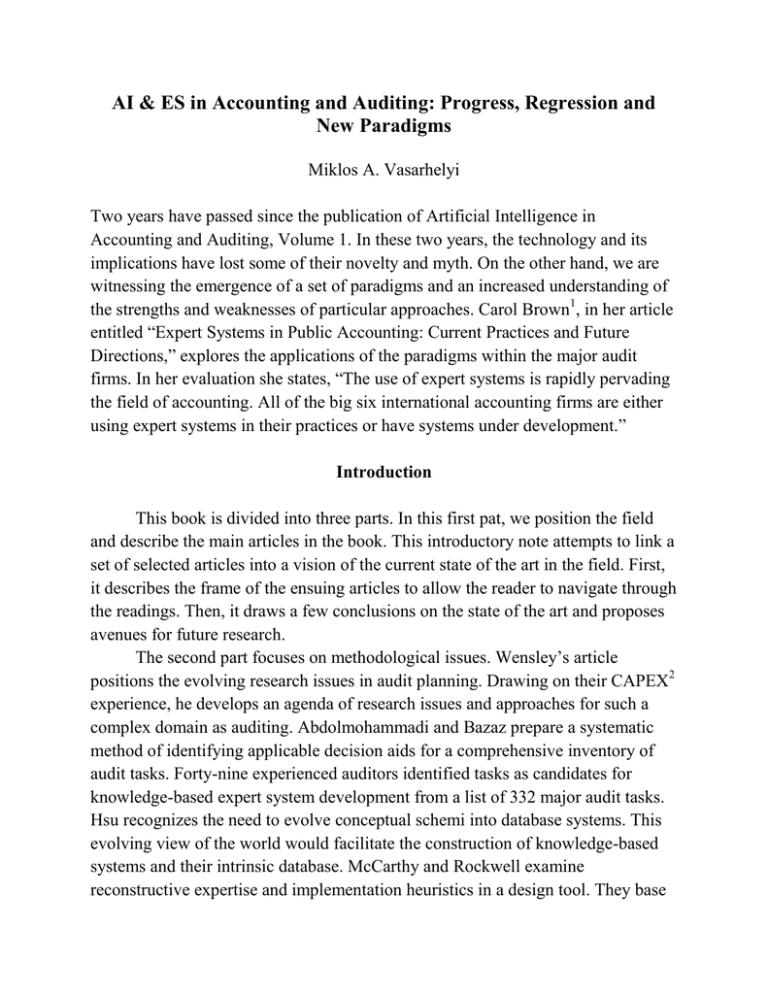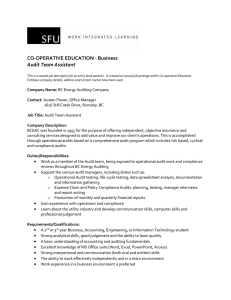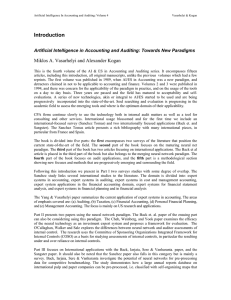AI & ES in Accounting and Auditing: Progress, Regression and
advertisement

AI & ES in Accounting and Auditing: Progress, Regression and New Paradigms Miklos A. Vasarhelyi Two years have passed since the publication of Artificial Intelligence in Accounting and Auditing, Volume 1. In these two years, the technology and its implications have lost some of their novelty and myth. On the other hand, we are witnessing the emergence of a set of paradigms and an increased understanding of the strengths and weaknesses of particular approaches. Carol Brown1, in her article entitled “Expert Systems in Public Accounting: Current Practices and Future Directions,” explores the applications of the paradigms within the major audit firms. In her evaluation she states, “The use of expert systems is rapidly pervading the field of accounting. All of the big six international accounting firms are either using expert systems in their practices or have systems under development.” Introduction This book is divided into three parts. In this first pat, we position the field and describe the main articles in the book. This introductory note attempts to link a set of selected articles into a vision of the current state of the art in the field. First, it describes the frame of the ensuing articles to allow the reader to navigate through the readings. Then, it draws a few conclusions on the state of the art and proposes avenues for future research. The second part focuses on methodological issues. Wensley’s article positions the evolving research issues in audit planning. Drawing on their CAPEX2 experience, he develops an agenda of research issues and approaches for such a complex domain as auditing. Abdolmohammadi and Bazaz prepare a systematic method of identifying applicable decision aids for a comprehensive inventory of audit tasks. Forty-nine experienced auditors identified tasks as candidates for knowledge-based expert system development from a list of 332 major audit tasks. Hsu recognizes the need to evolve conceptual schemi into database systems. This evolving view of the world would facilitate the construction of knowledge-based systems and their intrinsic database. McCarthy and Rockwell examine reconstructive expertise and implementation heuristics in a design tool. They base their considerations on the REACH systems that was designed to aid in the process of database design in general in the sub-processes of view modeling and view integration. Wensley and Boritz, still in an audit planning context, use their CAPEX3 experience to review and examine validation issues. The last article of this session (Winkler & Massaad) introduces the evolving neural network paradigm to accountants and explores its implications. The third part presents AI/ES in Accounting and Audit Practice. Brown surveys the field with particular concern for practices in public accounting. Vasarhelyi and Halper, as well as Vasarhelyi, Halper and Ezawa, propose a new “online auditing” paradigm and examine the implementation of the CPAS technology performed at AT&T. two additional articles are included in this section as illustrations of potential application areas. Messier and Hansen deal with bankruptcy prediction. The paper reports on the results of an experiment designed to assess the effectiveness of an inductive algorithm for discovering predictive knowledge structures in financial data. Kandelin and Lin use object-oriented programming to help in the credit decision making process. Volume 2 of this series opens the path for Volume 3, being published simultaneously, which includes sections on Knowledge Elicitation and Representation, Belief Nets and Bayesian Revisions, Accounting Applications and the Future in AI & ES. ENDNOTES 1. Brown, C., “Expert Systems in Public Accounting: Current Practices and Future Directions,” Expert Systems with Applications, Vol. 3, 1991, p. 3. 2. Boritz, J.E., and Wensley, A.K.P., “CAPEX Technical Manual Version 1.0,” Unpublished Manuscript, School of Accountancy, University of Waterloo, Ontario, N2L 3G1, Canada, 1989. 3. Boritz, J.E., and Wensley, A.K.P., “Structuring the Assessment of Audit Evidence: An Expert Systems Approach,” Auditing: A Journal of Practice and Theory, 1990.





